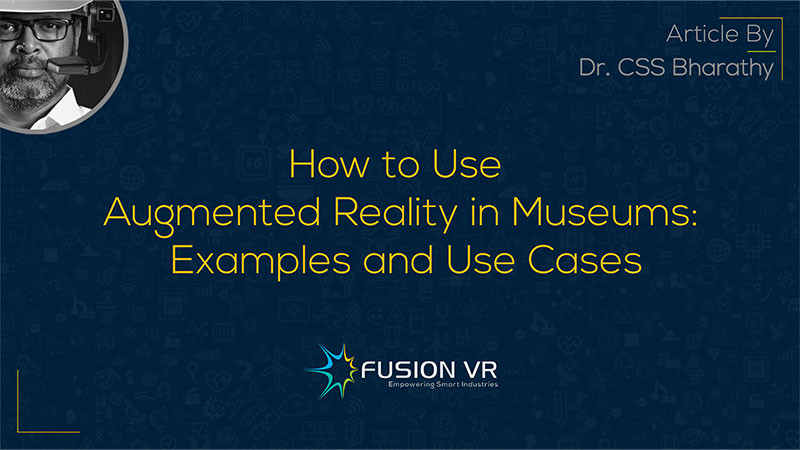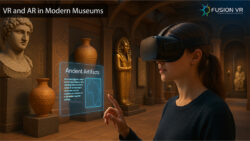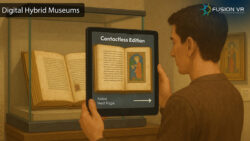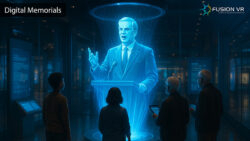Museums have always rendered themselves as the primary custodians of a nation’s cultural, scientific and historical heritage. In the 21st century, we have seen the emergence of private museums that cater to various interests. You may be surprised to learn that there is a museum for selfies in many cities across the world. Clearly, the museum scene is evolving very quickly to encompass a wide spectrum of groups and interests. These developments are healthy as they capture the lifestyle and trends of a particular time period for the interest of future generations. As the number of types and number of museums increase, there is a competition brewing to attract visitors to experience these museums. This has led to museums, particularly traditional museums, to transform themselves into interactive museums. To enable this transformation, museums have turned towards technologies that help museum experiences become interactive. It goes without saying that such engagement and interaction make museum experiences quite memorable.
Museums have started to leverage technologies like virtual reality and augmented reality and deploy high-quality hardware and software by collaborating with expert solution providers like Fusion VR. Augmented reality is rapidly growing in all areas of human activity and the museum sector is no exception. Many museums across the world have deployed augmented reality to enhance the quality of their visitor experience. We have been involved in taking museums to the next level for more than a decade and are intimately involved in the deployment of augmented reality with esteemed museum clients across the nation. Let us look at examples of how augmented reality is being used in museums to deliver a wholesome interactive experience for visitors.
Example 1. Time Travel with History.
This is a great way to use augmented reality in museums. The visitor has the custom-built AR application on their handheld device, a tablet or smartphone, depending on their convenience. This could also be a wearable, like an AR goggle which allows the visitor to view artifacts through it and also benefit from the digital overlay on what they view. These devices could be their own or one provided by the museum. The visitor views this artifact through the application and is immediately presented with the option to experience a great deal of content about it. This content could be activated by a QR code or by the app recognizing it by a scan of its contours or its unique features. The artifact could now be seen in its original environment, with its creator and the history of how it travelled from its original location to its place in the museum. Let’s say this artifact is the Mona Lisa at the Louvre. We could have a digitally created version of Leonardo da Vinci pop up and explain how he actually painted it. What a wonderful way to hear about the painting from the original, through virtual creator. This is a use case that could be applied to almost every artifact. The research about each artifact is available from the museum staff, historians and educators. The creative teams are ready to deploy this information into engaging and entertaining content for the visitor. The overall experience is quite memorable for visitors of all ages.
Example 2: Learning opportunities for school kids.
The museum is and has always been a great place of learning for people of all ages, particularly school children. Schools have begun integrating museum learning opportunities into their curriculum. Learning history, science, art, and culture is a little bit easier with greater retention with assignments at the museum. Museums have great exhibits that could be leveraged to achieve the unique learning objectives set forth in the curriculum. In addition to these, interactive learning stations are established where they can engage children with the assigned exhibits. Take for example, the assembled skeleton of a dinosaur in the museum. It is often left to our imagination, what the dinosaur actually looked like in flesh and blood and how it moved. Also, there’s no way to know what its original habitat looked like and how it moved in its environment.
The learning stations with large high quality displays are positioned in front of the skeleton exhibit. These stations are loaded with learning solution and present a menu that allows the kids to choose the tasks or experiences they need to accomplish. These experiences are also gamified to make the learning experience more interesting. The young person is now able to view the dinosaur skeleton through the screen and choose to see the dinosaur in real life, its movement in its digitally created environment, its feeding habits, and even how it manages its young. There are opportunities to learn about the flora and other fauna at that time in the history of the earth. The exhibits can be designed to achieve the learning experience for different grade levels, allowing children at secondary levels for more complex assignments. Quizzes and assignments integrated with these exhibits allow kids to earn credits for the learning experience.
Example 3: Personalized Guided Tours.
This is one of my favourite examples of an AR use case for museums. This is great for traditional museums in a building or open air museums. Most museums around the world particularly in India face a shortage of knowledgeable guides. This results in visitors entering the museum, walking around and seeing what catches their eye and miss most of the most interesting exhibits and the exciting history or details about them. This is not just a waste of time, but most importantly, an excellent opportunity lost to enrich them with the glory of their history.
Everyone has a smartphone these days, which are powerful computing machine in their own right. AR applications are designed to perform on these devices quite effectively. This application launches to provide the visitor with an overview and a list of tours that are designed based on the time available for them on that day. These tours can be paused and resumed at any time. The tours can be customized based on their interest and specific desires. The application uses location data to help the visitor navigate with audio and visual guidance through the AR museum. It prompts the visitor to stop and view each exhibit. Like a real life guide, it provides greater detail about the exhibit as it’s viewed through the device’s screen. It can also provide greater detail than even a guide could imagine, like enabling them to see a highly realistic 3D model and rotate it and view its detail from all angles. This personalized guide can do more as per the guide and delivers a more meaningful experience for visitors.
In use cases, where the museum exhibits contemporary artists, we could bring virtual versions of these artists to present details about their art themselves. Museum directors and curators play a vital role in how we deploy technologies in museums and how applications are designed and enable developers to provide the best possible interactive experience possible.
The ecosystem in India and elsewhere is quite advanced to nurture greater deployment of augmented reality in new museums and increase conversion of traditional museums into adopting the Museum 2.0 standards. Fusion VR is part of this ecosystem and is at the forefront of enabling AR applications in several leading museums and corporate experience centers in India. The Amma Memorial Museum and the RKM Museums are notable examples of our stellar efforts. We trust that these examples drive further adoption of AR in museums across the world. We believe technological innovations should continue to be integrated with the museum experience and enrich the overall visitor experience.





